Picture a cup of rich, dark coffee adorned with a velvety layer of thick foam, inviting you to explore to the very bottom of the cup. Turkish Coffee is famed for its robust taste, deep aroma, and the unique preparation ritual that accompanies it. Each sip is a dance of flavors, a cascade of chocolate, dark fruits, rich nuttiness, followed by bitter and sweet notes, that coat the mouth and linger on the palate - and that is exactly what this Turkish Coffee Recipe achieves.
Amid the bustling streets of Istanbul, beneath the tranquil shade of ancient trees, and within the intimate corners of traditional Turkish coffee houses, a centuries-old ritual unfolds-an aromatic elixir that bridges time and heritage. Welcome to the enchanting world of Turkish Coffee. Steeped in history and brimming with flavor, this rich, full-bodied coffee is not merely a beverage; it's a sensory journey that encapsulates the essence of Turkish culture, while serves a remnant - and reminder - of the Ottoman imperial legacy far beyond Turkey itself
Authentic Turkish Coffee, or "Türk Kahvesi" as it's known in the local tongue, is more than just a coffee; it's a cultural phenomenon that has stood the test of time. Dating back to the height of the Ottoman Empire, Turkish Coffee holds a cherished place in the hearts of those who have reveled in its depths for centuries. This ancient brew has witnessed the pages of history turn, silently bearing witness to the clandestine conversations, diplomatic negotiations, and fanicful tales spun in its presence.
Brewing Turkish Coffee is an artful ritual that goes beyond merely creating a beverage-it's a labor of love. Today, we're going to show you how to brew the perfect cup of Turkish Coffee, the traditional way. If you're a coffee lover, this is one recipe you absolutely must have in your repertoire.
Now, without further delay, let's dive right in.
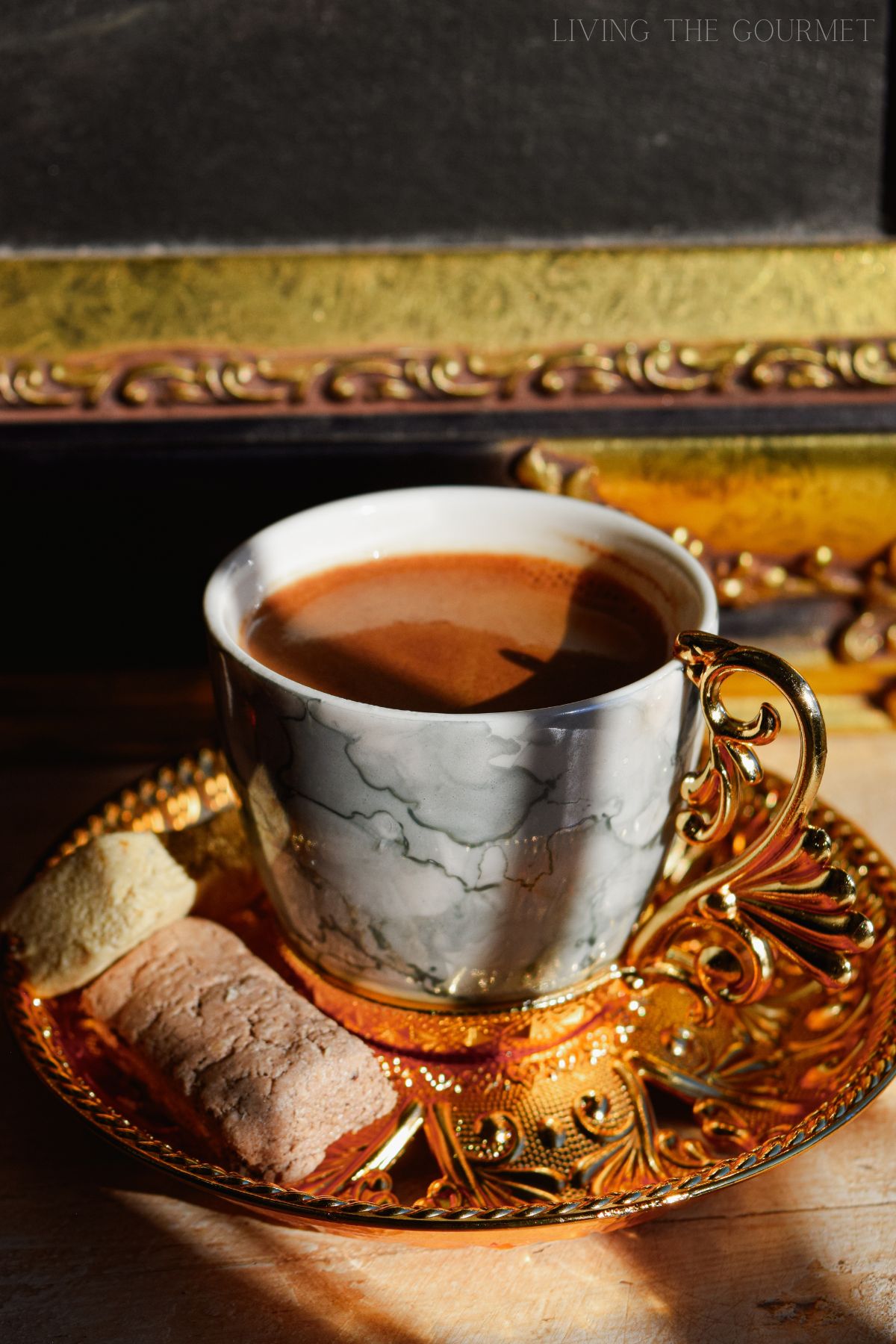
Turkish Coffee - Starting at the Beginning
At its height, the Ottoman Empire stretched from Algiers to the Persian Gulf, and from Budapest to Massawa on the Eritrean coast. Coincidentally, or not, almost everywhere the Ottoman Empire established itself for any length of time now consumes their eponymous 'Turkish Coffee,' especially in Greece, Bosnia, and Armenia - and the recipe is astoundingly similar across continents and cultures.
In Greece, in particular, this type of coffee functions as something of a 'national drink' alongside ouzo. However, this coffee is also enjoyed across North Africa and parts of the Arabian Peninsula.
Around 1540 or so, the Ottoman governor of Yemen, Ozdemir Pasha, noted his subjects were increasingly indulging in a particularly unique beverage - coffee. Whether he saw commercial potential in the drink, or simply viewed it as a cultural novelty worthy of note, is unknown. Either way, he was impressed enough to bring beverage to the attention of the Ottoman Sultan himself, Sultan Suliman the Magnificent, sending bags of the stuff, along with brewing instructions, straight to the palace.
It was 'not' love at first sip.
Initially, the Sultan was entirely unimpressed with the drink, finding it to be bitter and unpleasant - an opinion shared by 'most' of his staff. However, the more culinary-minded of the Sultan's courtiers refined the drink in several ways - almost certainly brewing and tasting along the way.
First, they roasted the beans to what we might recognize as a 'dark roast' these days, then ground the roasted beans into a fine powder, and brewed the powdered coffee in purpose-crafted pots called 'cezve,' and added copious amounts of sugar. The coffee was a hit. Importantly, it was a hit not only with the Sultan himself, but with the entirety of the palace. In that regard, we can say that the development of the traditional Turkish coffee recipe was a matter of 'courtly coffee enthusiasts.'
From there, the drink became fashionable throughout the empire, and as coffee imports increased (bringing coffee prices down), the drink rapidly found its way into the lives of the general population - and this recipe became ubiquitous.
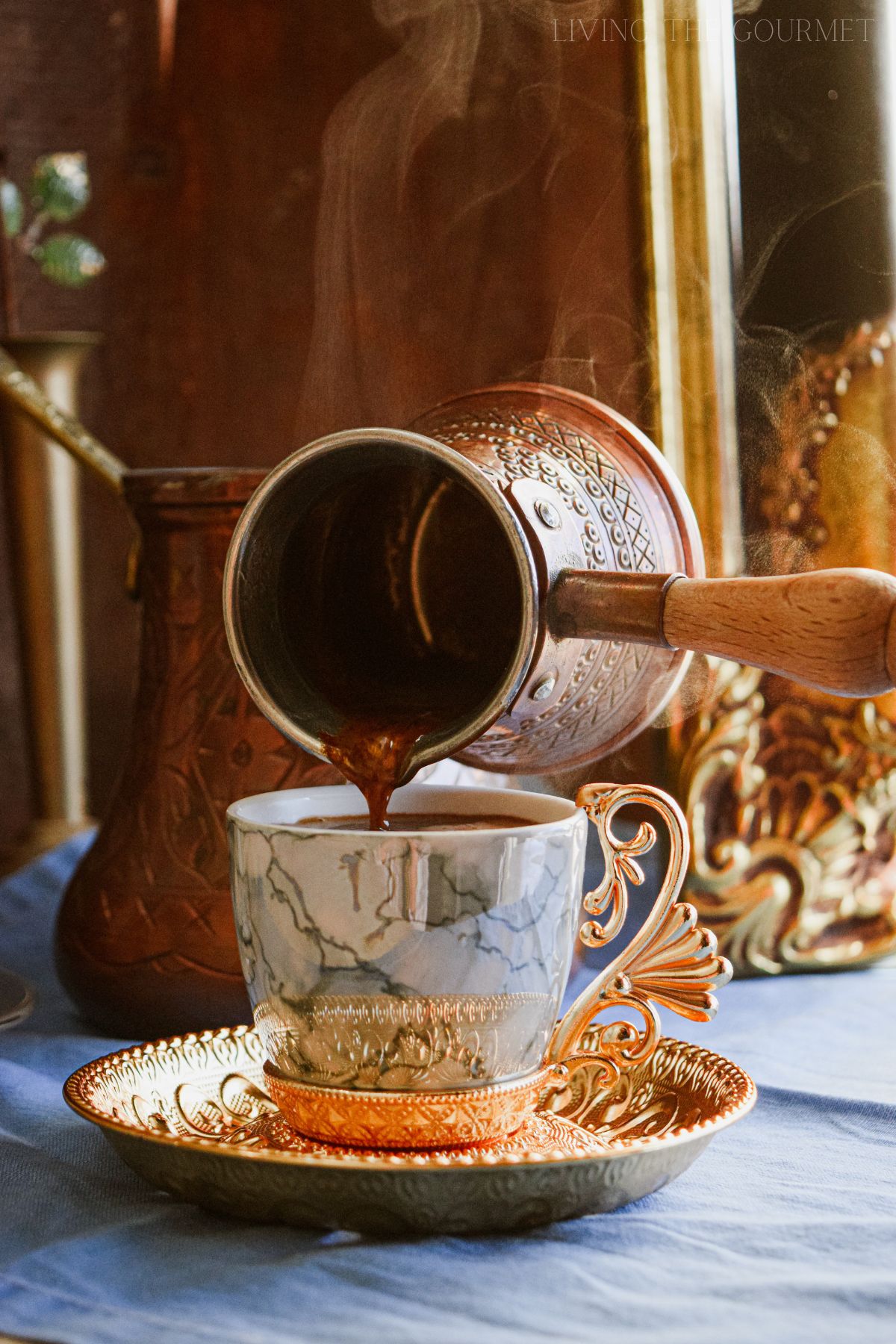
An Empire Loved Turkish Coffee - And Why You Should Too
- Truly unique taste and texture. I could sit here and describe the coffee's flavor as 'fruity' and 'nutty' without even a hint of 'coffee bitterness,' or I could try to convey its texture as 'pleasantly thick' or even 'syrup-like,' but instead I'll describe 'why' the coffee has these qualities so that it all makes a bit more sense. First and foremost, consider that Turkish Coffee typically has somewhere between a 3-to-1 and 1-to-1 coffee-to-sugar ratio, and that you are simmering your desired amount of sugar 'with' the coffee. Now, if simmering sugar in a pot with a relatively small amount of water sounds familiar, well…that's how you make syrup - yes, you are effectively preparing syrup 'in' your coffee. However, consider also that the process of preparing Turkish coffee has more in common with 'roasting' coffee than with 'brewing' coffee, which extracts a much larger amount of oils from the grinds when compared to preparing espresso or using a drip. These oils are going directly into your coffee, as opposed to being filtered through a machine or mesh filter - again, this cuts to the coffee's 'silky' or 'syrupy' texture. Tack on the coffee's natural 'crema' or 'froth,' and you can probably begin see why this coffee is loved as much for its texture and mouthfeel as for its flavor.
- It forces you to slow down. This is 'not' a coffee that you can rush - at any level. The preparation process simply demands that you set aside a solid ten minutes to prepare and enjoy your coffee. You cannot 'set it and forget it,' instead you need to watch the coffee like hawk, or you'll have a mess on your hands. You also cannot put it in a to go cup as that risks destroying the crema, and also risks disrupting the grinds, resulting in a thoroughly inedible coffee - not fun. Thus, fix yourself a Turkish coffee, and learn how to relax for a few minutes.
- A Ritual In a Cup. Brewing traditional Turkish coffee is as much a ritual as it is a recipe. From the specialized copper pot, to the unique preparation method, to more or less 'needing' to set aside a few minutes to savor the coffee, this particular type of brew more or less 'requires' something of a ritual. In Turkey, the coffee is often served in ornate 'coffee sets,' featuring demitasse cups and copious amounts of engraved bronzeware, and often alongside something sweet with small glasses of water for cleansing the palate. In Greece, the ritual is similar, giving rise to Greece's version of the midday 'siesta.'

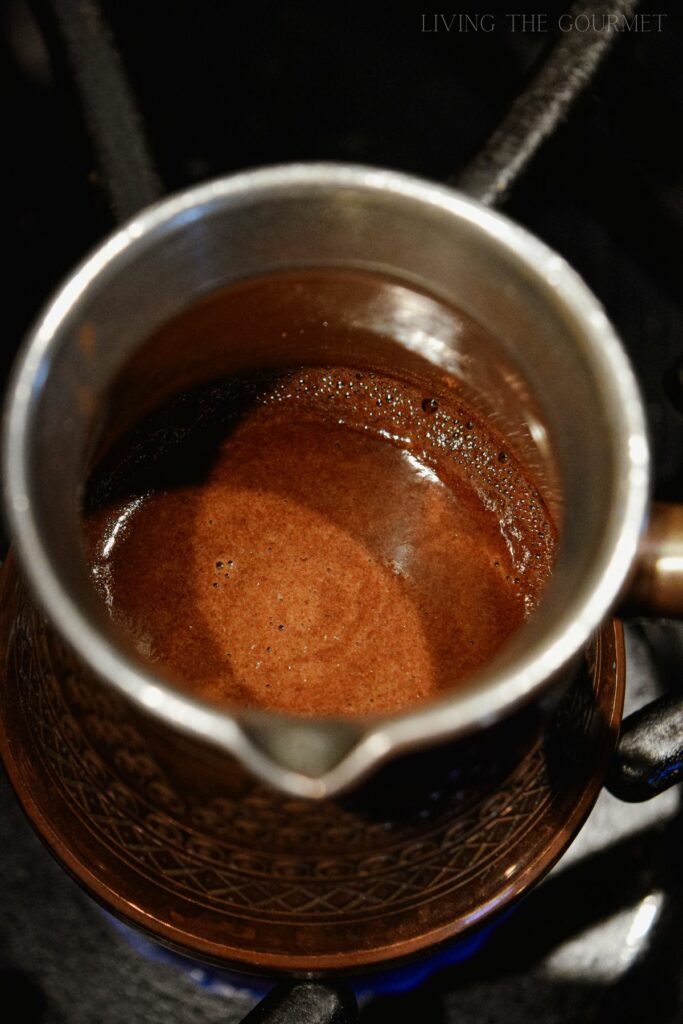
What You'll Need to Prepare Turkish Coffee
- Turkish-Grind Coffee. For this recipe, the first thing you'll need is a very fine grind of coffee. A 'Turkish Grind' refers to coffee that has been ground down to a fine powder, being similar in consistency and appearance to cocoa powder. This type of grind is a necessity for making Turkish Coffee. If the grind of your coffee is any larger or coarser than powder, the coffee will erupt in the pot volcano-style, making a sticky mess of your stove - I learned this the hard way early on. No, you cannot use espresso ground coffee, as even that's too large and coarse. Grinders at markets often have a "Turkish Grind" setting, and there are specialty grinders available that allow you to grind your coffee this finely at home. Conversely, you could buy this type of coffee pre-ground, with the most popular and widely available brands being from Turkey and Greece.
- Dark, Medium, or Light Roast? The recipe isn't picky, Turkish coffee can be prepared with either dark or medium roast coffee, it's a matter of preference. That said, lighter roasts are not recommended. Medium roasts will give a more 'fruity' flavor to the coffee, but at the expense of the 'warming' or 'chocolatey' notes found in darker roast coffee. Lighter roasts of coffee are not recommended for Turkish coffee because the brewing process involves boiling the finely ground coffee in water, which extracts its flavors and aromas. Lighter roasts have a higher moisture content and are less soluble, resulting in an uneven extraction and a potentially sour taste. Additionally, lighter roasts lack the depth and body needed to create the rich, bold flavor profile that is characteristic of traditional Turkish coffee.
- A 'Briki,' 'Cezve,' or 'Ibrik.' In essence, a small pot. While available in different sizes, ibriks are typically single serve. Briki, Cezve, or Ibrik are different names for a particular type of special pot made of copper. These pots feature a wide-bottom, a thin-neck, and a long handle. This unique shape facilitates 'gathering' the foam, as the foam will 'erupt' from the bottom and 'gather' within the neck of the pot, where it becomes dense and sticky. The unique shape also facilitates the 'quick-then-slow' pour, in which you quickly pour the foam into the cup, and then reduce the speed of the pour to a trickle, so as not to disturb the coffee's dense, dark foam. Conversely, some 'experts' suggest pouring as slow as possible from the get-go, which allows the crema to trickle out with the coffee. I've done it both ways, and had success with both. Note: Aside from copper, these pots are also available in stainless steel, glass, and silver, as well as silver lined copper.
- A Heat Source - Either A Gas Burner or Hot Sand. Street vendors and high-end Mediterranean bistros will prepare this coffee on 'cooking sand,' in which the temperature of the coffee is precisely controlled via how deep the barista presses the ibrik into the sand. Gas burners, while not as flashy, also allow similarly precise temperature control. Sorry electric stove owners, but this type of coffee more or less 'requires' the precise temperature management of a gas flame or heated sand. However, you 'can' move the ibrik on and off the heating element, and control the temperature that way.
- Demitasse Cups. Similar to espresso, Turkish coffee is served in decorative small cups, typically three and a half ounce demitasse cups.
- Sugar. How much sugar depends entirely on you, but it isn't uncommon for this kind of coffee to be brewed at as much as a one-to-one ratio of coffee to sugar. Which brings us to…
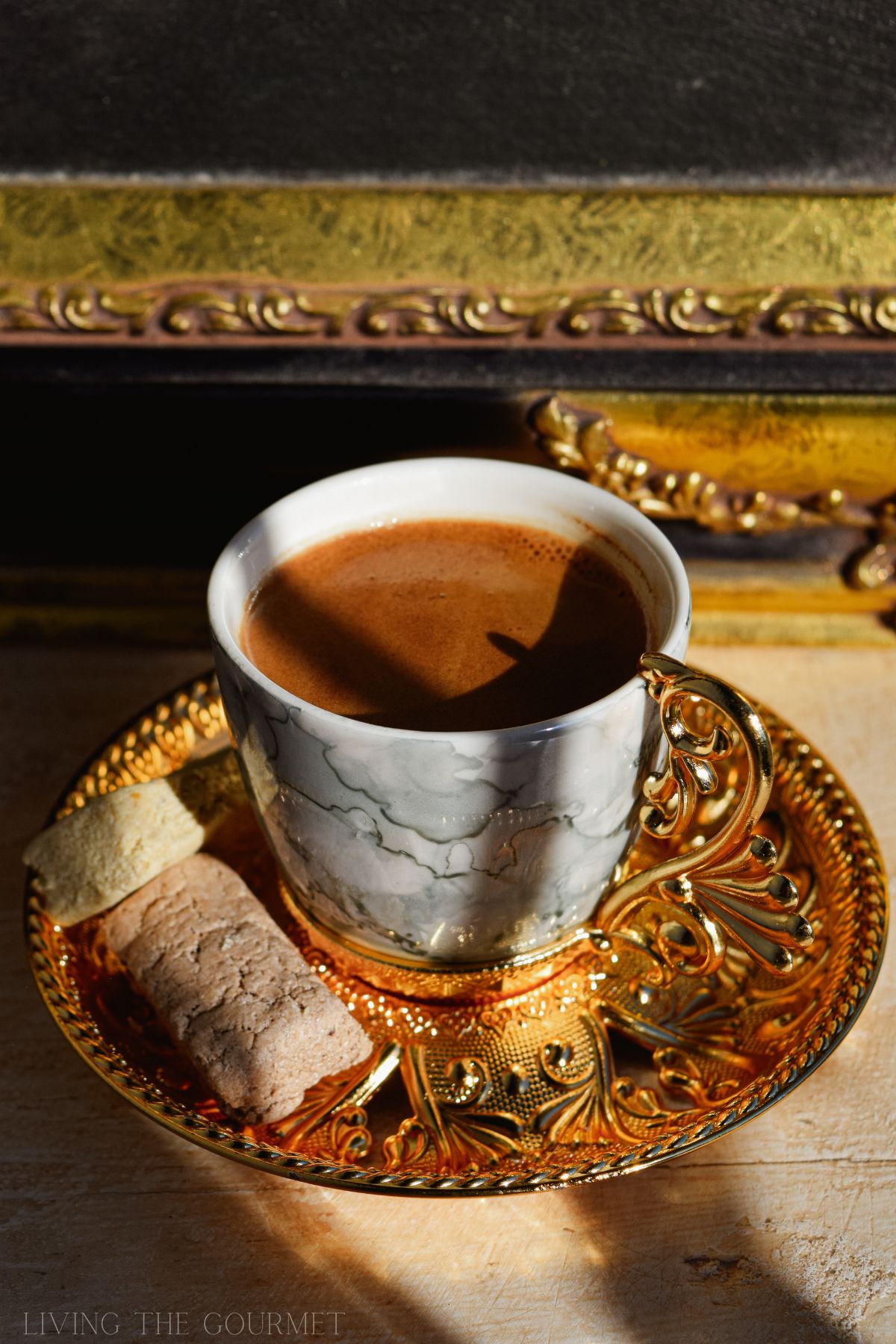
Sweetness Levels - Finding Your Balance
For any Turkish coffee recipe, the sweetness level - or lack thereof - is key. And there is no correct way to do it. Instead, sweetness levels are integral to personalizing the coffee to individual taste preferences. Here's an explanation of the different sweetness levels and how to prepare the coffee accordingly:
- Sade (No Sugar): This is the purest form of Turkish Coffee, without any added sugar. It showcases the natural flavors and aromas of the coffee beans.
- Az Şekerli (Slightly Sweet): For a touch of sweetness, add a small amount of sugar to your coffee. This level of sweetness enhances the flavors without overpowering the coffee itself.
- Orta (Medium): The medium sweetness level strikes a balance between the coffee's boldness and sweetness. It's a popular choice that complements the richness of Turkish Coffee.
- Şekerli (Sweet): For a sweeter experience, add a significant amount of sugar. This sweetness level creates a harmonious blend between the coffee's bitterness and the sugary notes.
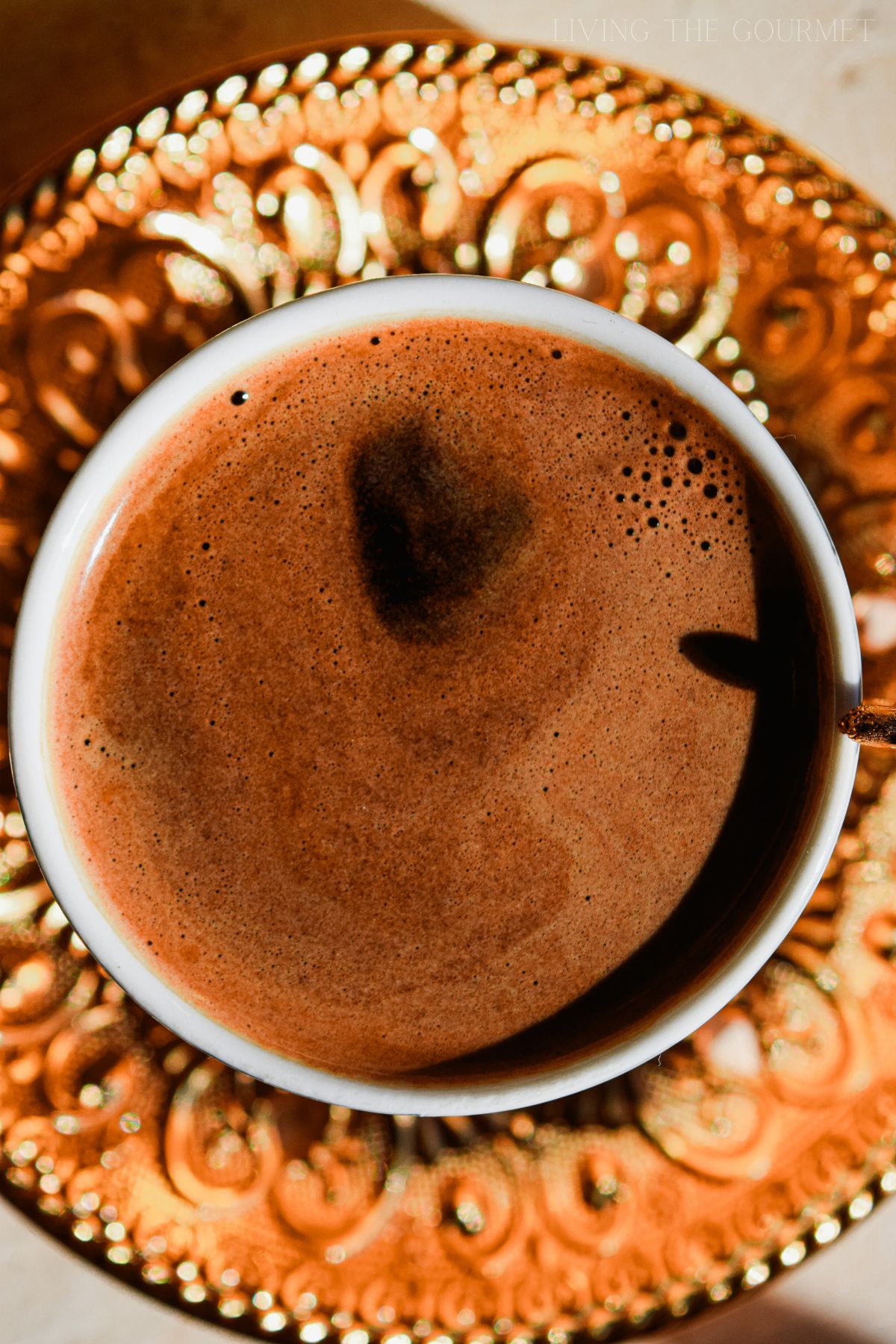
Preparing Turkish Coffee - General Pointers
- The Crema or Foam - More Than Looks. The success of your Turkish coffee is measured by the crema - and this recipe excels at producing crema. Turkish Coffee is perhaps best known for its dense characteristic crema, which is the foam that results from the accumulative extract of the coffee grinds and dissolved sugar. This froth isn't just for looks, though. Instead, it's indicative that a cup has been prepared 'just right.' Did you cook the coffee too long and let it boil? No crema - you boiled it away. Did you stir the coffee too much, too hard, or after the coffee was fully prepared? No crema - you stirred it away. Did you use too little coffee? Congrats on that thin to non-existent crema. Did you use 'too much' coffee? You'll have visible grinds in the crema. Did you not allow the coffee to set at the bottom of cup after pouring? Once again, visible grinds in the crema. Thus, a good-looking crema is simply indicative that the coffee was well prepared at each stage of the brewing process.
- Never Boil. Ever. Here's Why. Boiling the coffee, even briefly, ruins it. Some guides say to spoon the foam/crema into your cup, and then to boil the remaining coffee. No. This will result in ruining the 'dense' texture of the coffee by destroying the consistency of the dissolved sugar in the water - imagine the watery residue left after overcooking syrup. You will also 'over extract' the grinds, resulting in a coffee whose texture is thin, and whose flavor ranges from bland to sour or bitter, depending on how long you boiled it.
- Low and Slow. My burners have settings that range from one to five, with one being the weakest flame possible. I cook my Turkish Coffee just under the two setting, or very nearly as low as the flame goes. You want the coffee to cook slowly to aid in proper extraction, and to lengthen the 'simmering time,' while avoiding boiling altogether. If you cook the coffee to fast, you risk boiling, and limit the amount of time the coffee spends simmering. The end result will be a coffee that's overcooked - because you let boil - or undercooked, because you had to lift it off the flame too soon to prevent boiling. Low and slow, or not at all.
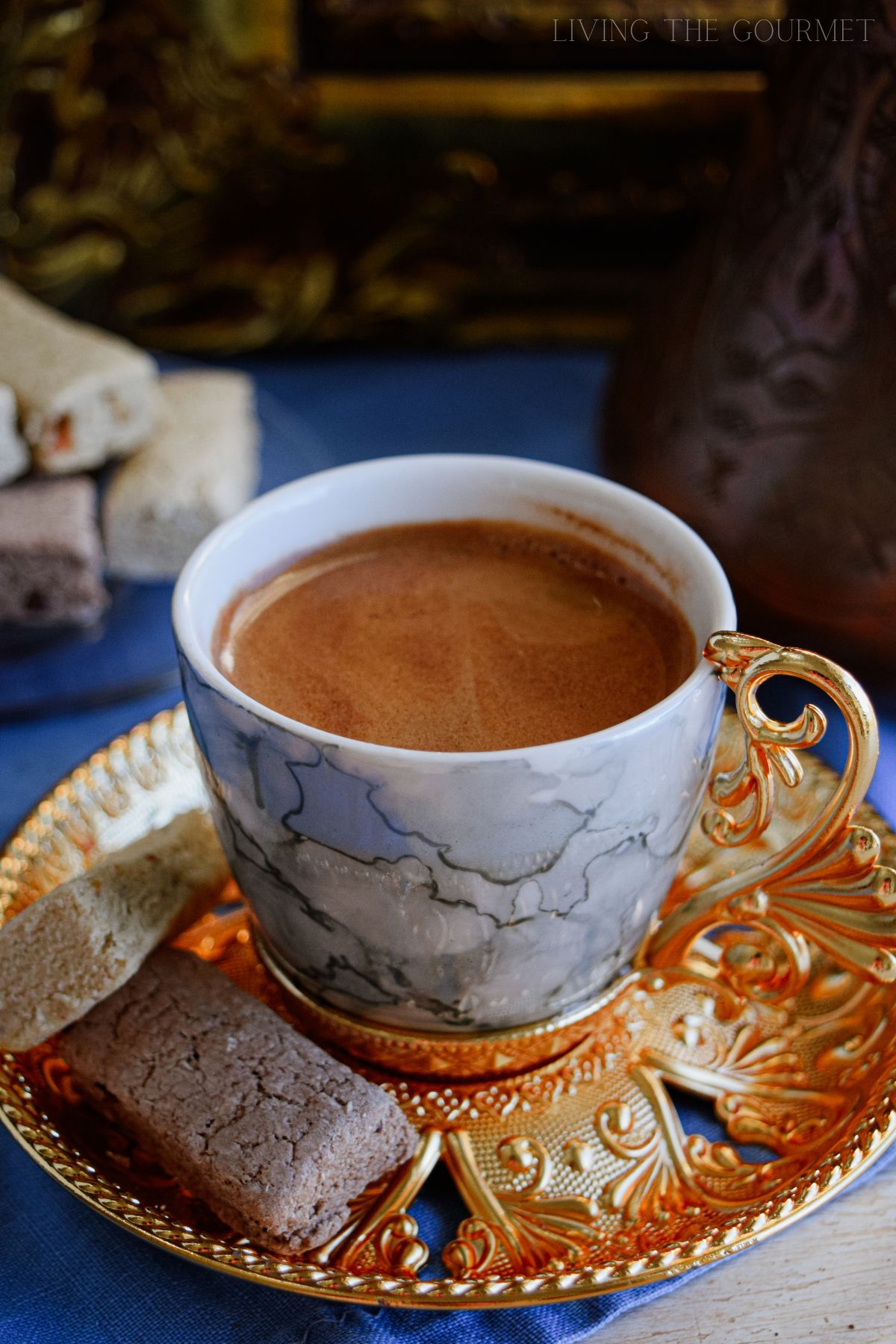
Serving Turkish Coffee
- A Glass of Cold Water. Traditionally, Turkish Coffee is served alongside a glass of cold water, this is to cleanse the palate before indulging.
- Something Sweet. The most common 'sweet' pairing with Turkish coffee is Turkish Delight. Shocking, I know. However, I've found that any marzipan based sweet works well, along with various artisan jellies and flaky pastries. I particularly enjoyed my Phyllo Pecan Tartlets with this coffee.
- Chocolate Is "Iffy." I'm positive that there are going to be a lot of people disagreeing with me on this point, but I have 'not' personally enjoyed chocolate with Turkish coffee. That isn't to say that they 'ruin' one another, just that to my palate the pairing is less than 'ideal.' In my opinion, the chocolate simply gets lost in the strong flavor of the coffee - which itself typically has strong chocolatey notes of its own. However, tastes vary, so test and see for yourself.
- Stay Away From Anything Savory. One of the very few things that Turks and Greeks agree on is that Turkish/Greek coffee is 'not' to be served with anything savory. This is very much a beverage to be served alongside something sweet, or merely on its own. Please, trust me on this.

Turkish Coffee
- Total Time: 15 minutes
Ingredients
- 3 Teaspoons of Turkish Grind Coffee
- 2.5 ounces of water
- 1-3 Teaspoons of sugar (optional)
- Pinch of Cardamon (optional)
Instructions
- Place the Turkish grind coffee in the cezve (Turkish coffee pot pictured above).
- Place your desired amount of sugar in the cezve.
- If using cardamon, add a small pinch of the herb now.
- Place the water in the cezve. Do NOT stir.
- Place the cezve over 'very' low heat.
- After the coffee grinds begins to sink, and the surface of the water in the pot begins to look 'mud like,' take a small spoon and very gently stir the mixture until it appears finely combined (roughly about fifteen rotations). Do NOT over stir.
- Wait for small bubbles to begin forming around the perimeter of the coffee. Bubbles may not appear around the 'entirety' of the coffee, that is fine.
- Once the bubbles have appeared, remove the coffee from the heat. If available, place the cezve on a cool surface - such as a granite countertop. This helps reduce the temperature more rapidly.
- Let the coffee rest for at least sixty seconds.
- Return the coffee to the heat, lowering the heat slightly.
- Allow the coffee to form bubbles a second time. When the bubbles start appearing, raise the coffee from the heat until the bubbles calm down, then lower the coffee back onto the heat, briefly allowing the bubbles to form a final.
- Pour the coffee.
- How you pour the coffee is very important. Either pour the coffee rapidly at first, and then reduce to a trickle. 'Or' pour the coffee very, very slowly from start to finish. In either case, a dense, uniform 'crema' should form over the top of the coffee, such that no coffee is visible.
- If the crema forms as in the pictures above, you have prepared the coffee properly.
- Prep Time: 5 minutes
- Cook Time: 10 minutes
And that's our guide on how to brew Traditional Turkish Coffee with an ibrik. If you enjoyed today's recipe or have any questions or suggestions about making Turkish coffee, be sure to let us know in the comments below. We always love hearing from you. Cheers!
4
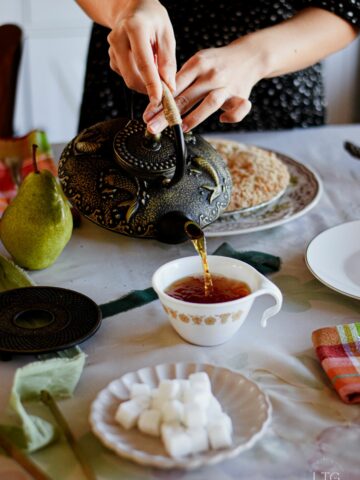






Celebrate Woman Today says
I really would like to try your way of coffee brewing in a delicate, Turkish way! I experiment with coffee-making often. And this post is yet another amazing experience to try this drink in a different way.
Rosey says
Good tip on the grind of the coffee. It would be very unfortunate to create a volcano effect.
Monidipa Dutta says
I had tried Turkish coffee in restaurant but but never made it on my own. As a caffeine addict I already love this recipe and I'm pissing it.
Yeah Lifestyle says
This is so good! There is a Turkish cafe near me and the owner makes a lovely Turkish coffee.
Luna S says
This sounds so good! I think my husband would really enjoy this as well, but I never knew how to make it before. Thanks for sharing this.
Karen says
I had Turkish coffee when I was in Turkey a few months ago and loved it! I can't wait to make my own, can't wait...Thank you so much.